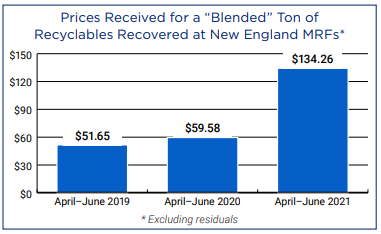Recently, the Solid Waste Association of North America (SWANA) reported encouraging news and developments in the recycling market. SWANA is the largest member-based solid waste association in the world with more than 10,000 public and private sector professionals. In November 2021, SWANA reported that over the last three years, the recycling market has worked to rebound and is currently seeing record highs in the United States as well as Canada. An example of this rise can be seen in the chart below, which demonstrates a 160% increase in two years for the average price of recyclables from material recovery facilities (MRFs) in the New England region of the U.S.
The United States recycling market significantly reduced in 2018 after China implemented its National Sword policy, which banned the import of several recyclable materials. Eventually, this progressed to nearly all scrap and recyclables. Before this policy, China was one of the largest importers of recycled materials in the world. With the sudden decrease in demand, the price for these materials decreased drastically.
Why have the prices of recyclables increased?
SWANA’s report stated four reasons why the prices have gone up.
- Paper mills in North America increased their capacity and continue to do so. Currently, 15 mills in North America have completed new capacity projects with more mills to follow.
- Due to the COVID-19 pandemic, the shutdown of businesses and schools essentially eliminated a source of comparatively clean cardboard and other fibers for recycling. However, the resulting boom in ecommerce purchasing resulted in a large amount of old corrugated cardboard being present in homes. This increased demand for residential recyclables.
- A new business model in the U.S. has emerged: Recovered fibers are pulped and sent overseas, which has rapidly increased U.S. fiber exportation. Colin Staub from Resource Recycling, Inc. states in his article “Scrap paper exports jump 21% in first half of year” that within the first six months of 2021, recovered fiber exports jumped from 7.4 million to 9.0 million short tons. The graph below shows the top importers of U.S. recovered fibers in the first six months of 2021.
- Consumer brands have stepped in and established recycled content goals in an effort to increase plastic packaging recycling. Every Bottle Back, an initiative that endeavors to improve the collection of recyclable bottles includes large investments from The Coca-Cola Company, PepsiCo, and Keurig Dr Pepper. This initiative and others like it help U.S. households recycle millions of pounds of polyethylene terephthalate (PET), the plastic commonly used in recyclable plastic containers.
What does this mean for municipal recycling programs?
Municipal recycling programs play an integral role in supplying manufacturers with secondary materials. The current trends are a result of these programs adapting and persevering despite China’s SWORD policy and the COVID-19 pandemic. Although the recycling markets are currently at a high, the market generally fluctuates year to year. For these programs to achieve sustainability, additional fees and charges may be seen by customers in the upcoming years to maintain recycling programs during the market lows. In the end, a variety of funding will be essential to keep this public service viable, sustainable, and an important part of protecting and enhancing the environment of the communities we work, play and live in.
SWANA’s report can be found at https://swana.org/docs/default-source/resources-documents/arf-documents/recycling-markets-have-strongly-recovered-final.pdf
If you have any questions on solid waste, municipal programs, carting, or the rebound of the recycling market, please contact Walden by calling 516-701-1681.

